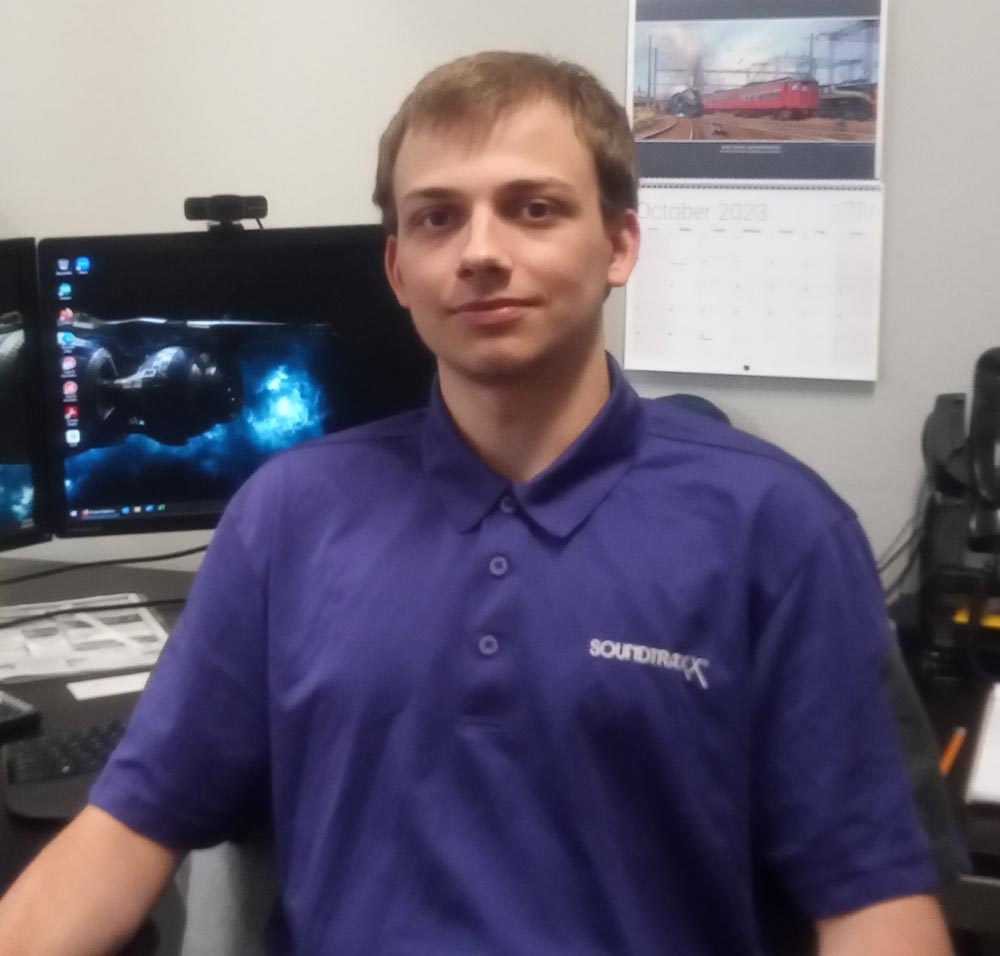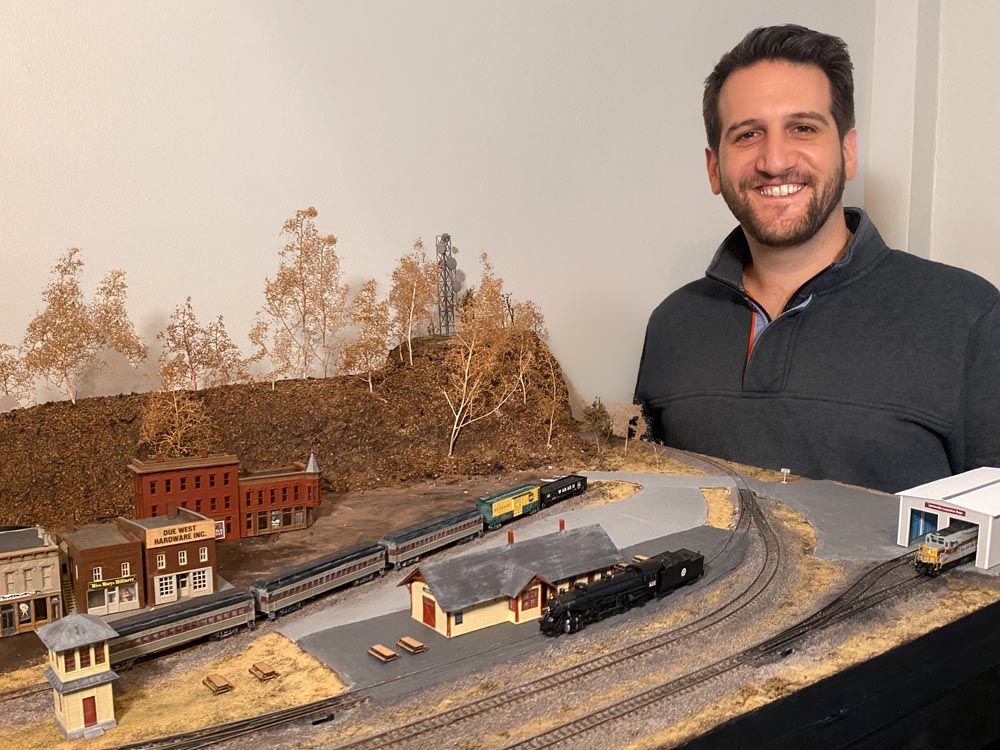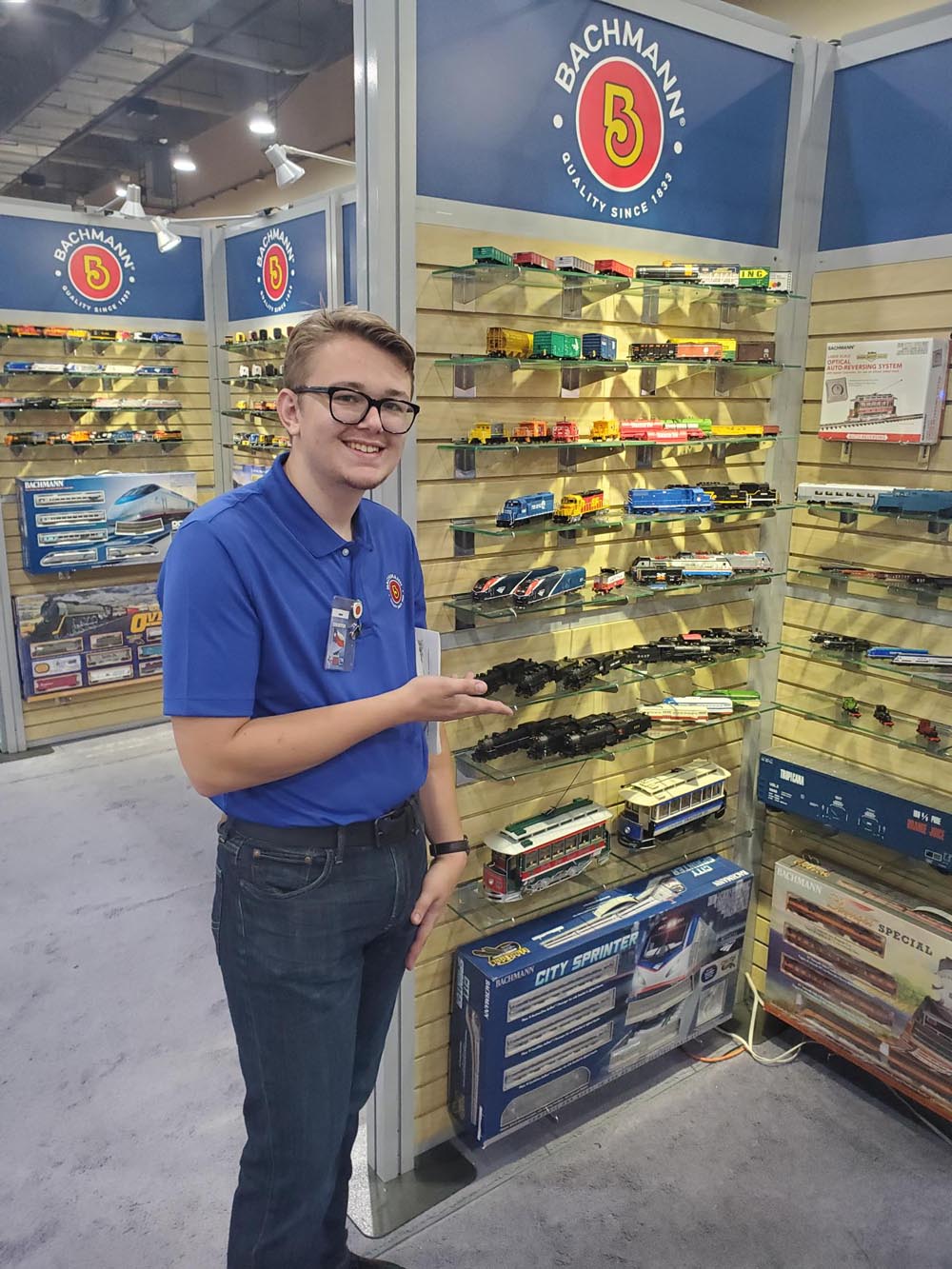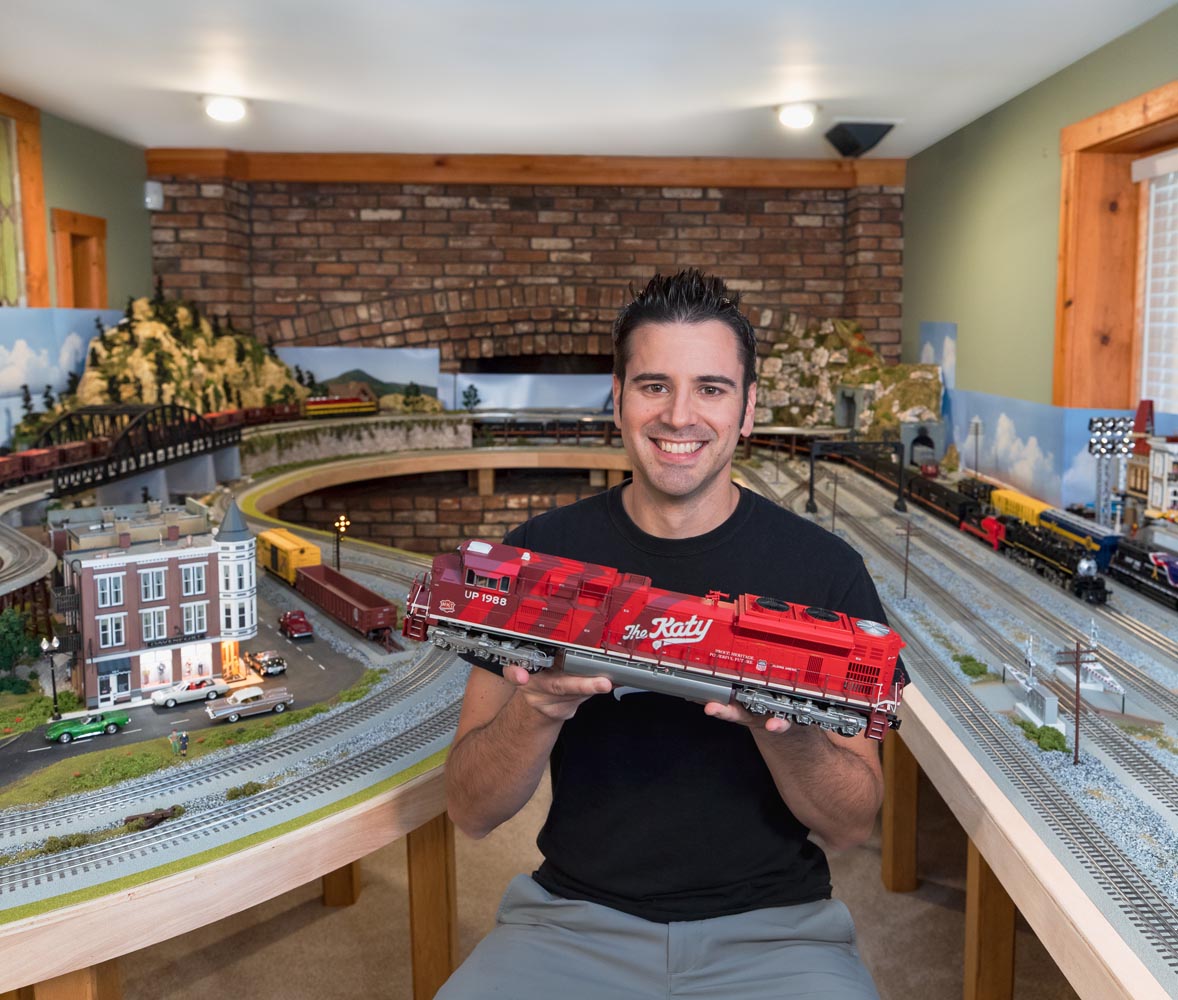While I was walking through the National Train Show earlier this year in Grapevine, Texas, I noticed something – there were a lot of young people working for the various manufacturers present at the show. As a young person myself, this gave me great joy. With discussions about the longevity of the hobby occurring daily on internet forums and even during a clinic in one show I attended, I figured it was time to show the facts about the young men involved in the hobby. Not just modelers, but those working in the industry as well. They are the next generation of model railroading.
If you’re a younger person involved in the hobby, we’d like to hear from you. Email me at bsleppy@modelrailroader.com and tell your story!
Norman Carnaby (SoundTraxx)
How did you get started in the hobby or industry?
My father ran a hobby shop in Hampton, N.H., prior to the 2008 recession and was an N scale modeler himself, so it was only natural that I would also get into the hobby through that connection. Granted at the time I didn’t have much more than one or two locomotives and a few randomly assorted cars to pull behind them, and there were times throughout my schooling where I would be focused on other things. However, when COVID hit it gave me the time to actually start to focus on the hobby. I had a couple of sound-equipped locomotives at this point and wanted to add more so I started doing my own installations, which is how I came to the attention of SoundTraxx.
What is your position at SoundTraxx?
I am the customer support technician, so if you are ever having an issue with your decoder or its configuration, you can call SoundTraxx (at 970-259-0690) and I can help you through fixing the issue or configuring any feature of the decoder. While I am not the primary repair technician, I do test all decoders that come in for repair before they go to him. I also am trained to be able to repair the decoders as well to get the repairs turned around in a timely manner.
Do you have a favorite aspect of modeling? (structures, trains, scenery, etc.)
I have always had an affinity for all things mechanical. One of the things that I have spent a lot of time on and really enjoyed is the process of getting all of my locomotives and rolling stock running like Swiss watches. I do so by hunting down issues in the mechanism, figuring out why this locomotive is not running up to the standards I set, and troubleshooting electrical pickup issues. That process is quite fun for me.
What’s your favorite era of train to model or run and why?
I actually have two fleets which I operate. I have my N scale fleet which is models the electrified regions of Conrail in the mid 1970s just after the railroad formed. Electric locomotives have always fascinated me, and I see very few people modelling electric districts exclusively. I thought it might be interesting to do an electrified region of a railroad with fully catenary. I specifically chose Conrail due to the wide array of electric locomotives they had available from all their predecessor railroads. I also have my OO scale fleet which models British Railways in the mid 1950s, primarily with the BR standard designs of steam locomotive. I know a lot of people prefer the big four locomotives to the BR standards. However, I have always had a soft spot for them, and it does mean I can model anywhere in the U.K. without needing to restrict myself to one locomotive or another based on where in the U.K. they ran.
What’s your vision of the industry/hobby 20 years from now?
I think a lot is going to change, not just as a result of the changes in the hobby, but also changes in how our lives function. For instance, I think we are going to see a lot less of the big regional or national conventions (not that they are going to go away completely). However, I do think we are going to see a lot more local scale conventions where maybe a dozen people bring modules and trains to run in a relatively small space and set up and run for a day. Maybe in a town where a local retailer exists so they just hop over a couple of blocks to the store rather than having a retailer set up a booth. This will be easier from a scheduling and financial standpoint for all involved than the big conventions are currently.
I also think we are going to see a lot more “homegrown” stuff, given how prevalent 3-D modeling skills are and how accessible 3-D printers have become. I am currently looking to use a 3-D printer for just this. I plan to have a layout with a port, however the ship I want to dock there, the NS Savannah (A fascinating little ship if you’ve never heard of it) does not exist in model kit form in a scale which would be suitable for an N scale layout. So, I am attempting to find a good 3-D model of it which I can then print on my 3-D printer so I can have it sitting in a port on my layout.
Frank DeStefano
How did you get started in the hobby?
My maternal grandfather, Gene Parrotta, instilled a love of trains in me, both full size and miniature, from an early age. He built a classic basement-sized O scale layout over the course of 20 years featuring Lionel and MTH trains running through masterfully crafted scenery and scratchbuilt structures. At Christmas time he’d set up three levels of LGB trains on the front lawn to run alongside lights and speakers wrapped in gift wrap playing holiday music, all to the delight of the community. He also had a collection of around 100 issues of Model Railroader from the 1980s to the 1990s, which I obsessively thumbed through as a kid.
I dreamed of someday making my own model railroad creations and finally got to turn this into reality in my 20s when I entered my career and had the space plus income to tinker. That’s around the time I set to work on what became The Flushing & Brooklyn Rail Road, my 1830’s HO scale table top railroad which was featured in the September 2023 issue. I’m very thankful my grandfather shared his passion with me, it’s a hobby that has proved an additional creative outlet in my life and brings many of my individual interests (trains, history, creativity, painting, planning, project management) together.
What’s your favorite era of train to run or model and why?
I have a soft spot for modeling the 1800s, in particular the 1830s during the industry’s pioneer era, because of how fascinating I find the time period from a historical point of view. I love the general aesthetic of locomotives and rolling stock of the Victorian age, but I also admire how at the time they were revered as the pinnacle of human scientific achievement. Modeling this era, as I learned firsthand, is quite challenging due to the lack of available commercial products, but it’s worth the extra effort to kitbash engines and rolling stock and bring scenes from the past to life.
That being said, from an operations perspective nothing in my mind beats modern railroading. As a weekend warrior volunteering on tourist railroads, it’s fun to re-create operating practices I’ve experienced firsthand (both NORAC and Standard Code) in miniature. I really enjoy modern shortline operations for their charm, eclectic equipment, and general atmosphere. These characteristics offer great modeling opportunities which I hope to someday re-create on a future layout.
Do you have any future layout plans?
If anything I have too many ideas for the future which I’ll have to pare down! For now, I’m building an N scale tabletop layout featuring a fictional regional railroad called the New York Midland (loosely inspired by the Reading & Northern) set in the present day around early winter. It features the Carolina Central track plan Model Railroader pitched about twenty years ago with some slight modifications.
I also sporadically work on a small switching layout re-creating a “Spaghetti Western” railway scene set along a branchline in Spain circa 1968. For those unfamiliar with the cinematic term, the Spaghetti Western was a movie genre from the 1960s of Italian-produced westerns filmed in Spain to substitute for the American southwest and featuring mostly European actors. But one or two up-and-coming or waning American movie stars were cast in leading roles for marketing credibility. “The Good, The Bad, and The Ugly” is probably the most famous example of the genre, but its director’s next film, “Once Upon a Time in the West,” is my personal favorite and inspired my choice of career (and features trains very heavily). The layout will include a worn-out Spanish steam engine decorated to look American with phony bonnet stack and “cowcatcher” pilot plus railway carriages featuring American road names and a small movie production crew filming a western at the Spanish railway station adorning an American town name. Future layout ideas include a modern shortline railroad, and a possible revisit to the 1830s featuring a different railroad from my previous Flushing & Brooklyn.
What’s your vision of the hobby 20 years from now?
I personally think there’s a very bright future ahead, as I notice many young modelers are entering the hobby and new products emerge every year that make our lives easier. I think there will be a shift in what we see modeled; namely a greater emphasis placed on creative new ideas rather than repeating somewhat cliche themes (an example being the transition era Fallen Flag layout). Modelers traditionally would re-create what they saw as kids, but I think many of us young guns take an interest in many different eras and locales regardless of whether we experienced it firsthand or not. In my case with the Flushing & Brooklyn, I deliberately wanted to depict an era I could never see but always thought was extremely interesting. Modeling the era gave me the chance to bring static images from contemporary paintings and drawings to life.
I also believe that there will be a shift overtime in layout sizing, as many younger modelers have more limited space available for their hobby. I don’t believe the old school basement sized-mainline layout will disappear entirely, there will always be a time and place for them, but I think we’ll see more switching and compact designs emerge offering some fun new creations to marvel at in future issues.
Tyler Haney (Bachmann Trains)
How did you get started in the industry?
I always dreamed of making a career out of model railroading but didn’t know what a path into the industry looked like. As I was deciding on my career goals in high school and college, I took some classes in digital design and business, but ultimately majored in History with the hope of working at a museum or historic site. Unfortunately, I found that due to the pandemic, the openings in this field were very limited when graduating. As I looked for a new opportunity, I knew that Bachmann Trains was headquartered near my home, in Philadelphia, and I found a job posting on its website for assistant product manager. This posting noted that the position required graphic design and research skills, train knowledge, and the ability to assist in marketing. With my variety of education and experiences, I applied for this position and was ultimately hired in September 2021. Working in the model railroad industry is truly my dream job, and some days I can still hardly believe I’ve made it here!
What is your position at Bachmann?
I am the assistant product manager. Along with our vice president of product development, Larry Harrington, I work with our sales, marketing, and engineering departments to research and develop new Bachmann products in all of the product lines and scales that we offer. Most of my time is spent preparing production artwork from prototype photographs and research, and using Adobe Illustrator to recreate the railroad heralds, lettering, and paint schemes on line art diagrams. These artwork sheets are then used by our engineering team to prepare pre-production model samples, and ultimately the finished production models.
Besides preparing the artwork, I’m also responsible for reviewing the appearance of CAD drawings of new models, testing and giving feedback on the operation and appearance of pre-production samples, assisting with product marketing and advertising, and representing Bachmann at train shows.
Do you have a favorite aspect of modeling? (structures, trains, scenery, etc.)
Besides designing and re-creating the paint and lettering of locomotives and rolling stock, I enjoy developing track plans and creating layout scenery. At Bachmann, I’ve helped out with building and rehabilitating a collection of small layouts we use for trade shows and marketing photography.
Away from the office, I personally collected three-rail O gauge trains for many years and am currently building a modular N scale switching layout in my home. I enjoy modeling and collecting trains from the Pennsylvania RR and Reading Co. from the 1940s through the 1960s.
What’s your vision of the industry/hobby 20 years from now?
Twenty years from now, I hope to see the model railroad hobby reinvigorated with new modelers and collectors, and that the industry will be able to meet these new model railroaders with new products and technologies that make it easier to get started. I expect we will also see demand for continually higher-detailed and more prototypically accurate, ready-to-run models. I always tell people that Bachmann strives to offer a wide variety of products that appeal to both brand new model railroaders and experienced hobbyists, and we plan to continue this strategy for many years to come.
Chris Raines
How did you get started in the hobby?
My father introduced me to the hobby. I have participated in this hobby all my life and really ramped up in 2021. The extra time at home [during the COVID-19 pandemic] was a great chance for me, as it was for many, to explore the hobby and get to work on my own display.
What’s your favorite era of train to run and why?
O gauge postwar is my favorite era. The simple beauty of the models and the way some are considered far more valuable than others even though they share common traits, and the connection this era had to the “American Dream.” Of course, the reminder of my own childhood when my dad would break out the vintage set.
What’s your vision of the hobby 20 years from now?
I believe there will be more standardization from the manufacturers with regards to electronics and I see this traversing scales. I also see more open source, niche products forming via crowdsourcing. The models will always be familiar, as we are working from historical footprints.
The dioramas will always vary from highly artistic composition to minimalist loops. I see Generative AI making its way to the hobby. More input from customers on paint schemes and even the models themselves.
[Read about Chris and his love of the hobby in the May 2022 issue of Classic Toy Trains and follow his YouTube channel.]
Classic Toy Trains editor Rene Schweitzer interviewed Chris and his friends called “The Train Dads” in this special article.


















Model Railroading has to be appealing to the next generation or it will die. Tech is definitely a player with DCC/Sounds/effects on a layout. Younger people also initially have less space so a club or private small scale layout is preferred. Cost needs to be maintained for everyone as not to be priced out of the hobby. As with most hobbies, initial cost to get going is the shocker. Surrounding yourself with good counsel as not to purchase unnecessary items as they can disinterest the hobbyist quickly. Personal preference is to keep the modeling in model railroading. Adding detail, painting, descaling, and weathering are all p[art of the experience. For those that like a turn key out of the box venue, that should be available also. Many of these smaller companies can’t compete with the turnkey big model companies and sadly fall by the wayside. In general survey, modelers tend to model eras when they were age 15-25, maybe the best memories of life or favorite times. Interest tends to be age 3 to 15, then age 20 to infinity. Model railroaders are sometimes stereotyped as odd ducks or introverts. This is a fallacy. They are many worse harmful passions out there. Layouts do take floor space, but the hobby has expanded and spread out it’s roots to make room for future growth with options such as permanent clubs, modular layouts and the like. Recruiting, attraction and appeal have to be key factors to keep the hobby alive.
Very encouraging and a bright future for this hobby with these young folks blazing a new path and future for model railroading. If this hobby is to grow and expand into the years to come and even the next century, we need the next genertation of young folks to step up and take an active role whether it is in the hobby itself or the business and development side. Parents also need to encourage their children to take an interest in model trains and of course that has always began with the traditional Christmas Tree trainset or getting a trainset as a gift for Christmas. The older folks among us modelers also have to take an active role in helping and encouraging the young folks among us to consider the wonderful world of model railroading. May I also suggest that this hobby should not be just for boys and men but gitls and women also. There are quite a few females involved with the hobby but could use even more modelers amongst women and girls also. Model trains and model railroading is a wonderful hobby due to so many facets including artwork , electronics, mechanical and model building as well as scratchbuilding skills. Long live model railroading for this young generation and the generations to follow. Keep those trains rolling Joseph C. Markfelder